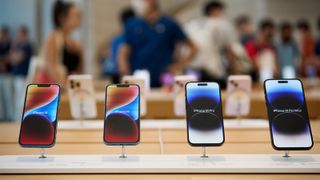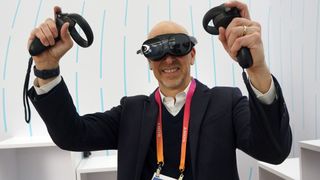Unimpressed by the Oculus Quest 2? Here’s how future VR headsets could beat it
This year we’ll be treated to a slew of new virtual reality headsets that look set to deliver next-gen experiences thanks to their technological upgrades.
The PlayStation VR 2 joins the Meta Quest Pro – which was released in 2022 – in delivering eye-tracking, which will allow developers to create more immersive and ambitious software experiences; the Oculus Quest 3 is believed to be bringing color-passthrough for more realistic mixed reality experiences to Meta’s budget-friendly lineup; and we could also see the long-rumored Apple VR headset, which reports have suggested will be ‘a laptop for your face’, with specs we can’t wait to try out.
But what will the generation of VR headsets after these deliver? For some possible answers we spoke to Leland Hedges, General Manager of the EMEA (Europe, Middle East, and Africa) region for headset maker Pico – here’s what he had to say.
Improving the current specs
Hedges first suggested the headset upgrades we can expect to see when the Pico 5, Oculus Quest 3, and Meta Quest Pro 2 launch: more of the same, but better. By this, we’re talking about devices with increased computing power courtesy of the latest generations of processors, using higher-resolution displays, and with improvements to the quality of existing color passthrough and depth sensors.
We’ll also hopefully see features that are currently exclusive to premium models – like face and eye-tracking – introduced to brands’ more budget-friendly lines (provided this wouldn’t add too much to the cost).
It’s not just about what’s under the hood, though, Hedges added that “a more comfortable form factor has a huge utility for users across the enterprise and consumer space.” If you can’t bear to wear a VR headset for very long, then upgrading its battery, and equipping it with laptop-like levels of computing power, is pretty pointless.
More VR content
As great as hardware upgrades are, Hedges noted that you need content too, otherwise you’ll be left with a powerful device that can’t do all that much. And not just more games.
“Currently VR headsets are seen as very gaming-centric devices, I think for VR to go ‘mainstream’ – if you want to use that word – we have to offer more types of experiences,” he told us.
That’s not suggesting that Pico is abandoning gaming anytime soon – Hedges said he couldn’t go into any detail about what IP Pico is developing and partnerships it has with developers (like the upcoming timed-exclusive release of Just Dance VR from Ubisoft), but added that he believes VR content can go further.
We’re seeing more and better VR concerts, people are watching sporting events in VR – we’re talking major leagues too, like the NBA on Meta and the FIFA World Cup on Pico – and people are working out in VR. Mental health could benefit from VR software too, with Hedges noting that “People are using VR experiences in exposure therapy, working to get closer to a spider or be more comfortable with heights.”
We’ll just have to wait and see what kinds of experiences are in the pipeline.
5G/6G connectivity
But a truly next-generation device can’t simply be one that does what came before in a better way; we need new and exciting features, and 5G or 6G connectivity would provide a lot of utility to a VR headset.
Hedges said he doesn’t think we’ll see this in the near future, but in the medium-to-long term he expects that a telecoms operator and XR headset maker will come together and create a “really compelling offering,” most likely in the business-to-business space.
The Meta Quest Pro and Pico 4 Enterprise headsets allow collaborators to meet in VR in a way that’s more interactive than a typical voice or video call. So, much as your company might want you to have a work phone so that you can take a business call from anywhere in the world, an employer might want its employees to carry a 5G headset around so that they can take a VR call wherever and whenever.
And with devices like the rumored Apple VR headset expected to offer laptop-like functionality, with high-end specs such as Apple’s M2 chip, which powers many of the best Macbooks and Macs, a 5G connection would make the device feel truly portable. You could set your VR office up almost wherever you want – although until battery life improves it’ll need to be somewhere that’s near a wall socket.
From a more consumer standpoint, portable 5G headsets open up the possibility for more interactive multiplayer mixed reality experiences. You and your friends could meet up in a virtual park and play a game of paintball, or sit on a virtual bench and play chess, to choose just a couple of possible use cases.
Modular design
Upgrades are great for our gadgets, but not so good for our wallets. So one way we could see manufacturers find a balance between offering budget-friendly headsets, and also offering options that appeal to prosumers (professionals and high-end users) is by making headsets modular.
We’re starting to see aspects of this already. Hedges was keen to discuss Pico’s upcoming fitness trackers – additional bands, which are currently being beta tested, that allow the Pico 4 to track more of the wearer’s movements. By slipping these optional bands around your ankles the headset is able to not only monitor your arm movements but your leg movements too, which would make the Pico 4 better for VR fitness fans (as their workouts can factor in their legs) and for gamers looking for more immersive experiences.
The upcoming Vive XR Elite from HTC is set to have a modular design too. Its battery pack is removable to make it more lightweight for wired VR, and HTC says it’ll be releasing an eye- and face-tracking add-on for the device in the future. If you just want the core product you’ll be able to pick it up for a seemingly reasonable $1,099 / £1,299 (around AU$2,300), and you’d only have to pay extra for the upgrades you care about.
For me, this modular system sounds perfect. I recently wrote about how I love the Meta Quest Pro, with its processing power upgrades, over my Quest 2, but the expensive eye-tracking isn’t worth it. If I could pick up the Quest Pro at a cheaper price, and optionally add eye-tracking when it becomes more useful, that would be fantastic.
Subscriptions and bundles
Speaking of making headsets more affordable, Hedges’ last proposal for a next-gen upgrade was about affordability – a factor which he and Pico are aware is one of the most important when it comes to consumer VR. So Hedges predicts that we’ll see subscriptions and bundles becoming more the norm for XR device manufacturers going forward.
We’ve seen a few VR hardware bundles over the years, but a lot of them have been kind of garbage – typically you’d just get the headset at full price, along with some add-ons you didn’t need. More recently Meta and Pico have been bundling software with their hardware and offering proper discounts; each company’s Black Friday sales not only reduced the headset’s cost, but also provided users with some of the best VR games for free.
Hedges added that bundles don’t just make the devices more affordable, but more approachable too. Users are given instant access to a good mix of titles that show them what their new gadget is capable of; once they’ve finished with those they’ll have a good feel for the experiences they do and don’t like, and can then find new content based on their informed preferences.
Another way we could see the next iteration of headsets become more affordable is via a subscription model – similar to a phone contract or Microsoft’s Xbox All-Access deal, with the cost of buying the device spread over a number of months. Buying a product in installments rather than outright has risks, but spreading the cost can make expensive tech more accessible.
We’re seeing some subscription models in the VR space already, but on the software side. Just like Netflix or Xbox Game Pass, HTC’s Viveport Infinity subscriptions give you access to a library of content (in this case VR games) that you can download and enjoy as much as you like for a $13 / £13 / AU$18 per month fee. I’ve previously said I think Meta should adopt this kind of strategy for the Quest 2’s software catalog, but we’ll have to wait and see if, for its future devices, it adopts this or any of the other ideas discussed here.





